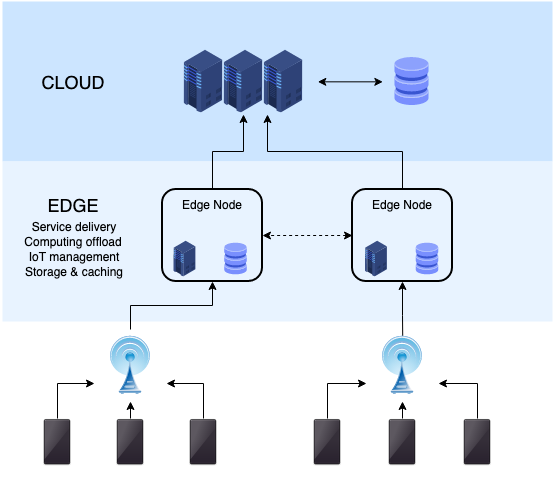Using Azure’s strategically placed edge nodes near financial hubs, the The New York Stock Exchange (NYSE) partnered with Microsoft to integrate edge computing capabilities into its trading systems, and can execute trades within microseconds.
The rapid evolution of cloud computing and the emergence of edge computing are revolutionizing industries, with financial services standing at the forefront. These technologies are not just enhancing operational efficiency, but also reshaping how financial institutions deliver services, manage risks, and interact with customers. The convergence of cloud and edge computing is enabling financial organizations to achieve unparalleled scalability, cost-efficiency, and real-time processing capabilities.
Let’s explore the significance of these advancements, and delve into some of the strategies for optimizing hybrid environments using cloud technologies.
The Importance of Cloud and Edge Computing
Meeting Rising Customer Expectations
Today’s consumers demand instant, personalized, and secure financial services. Cloud and edge computing enable financial institutions to meet these expectations by providing real-time data processing, seamless application delivery, and scalable solutions.
Driving Innovation
From algorithmic trading to fraud detection, financial services rely on cutting-edge technology. The cloud offers the computational power needed for advanced analytics, while edge computing brings processing closer to data sources, reducing latency and enhancing performance. The use of AI to optimize hybrid environments will become more prevalent, enhancing decision-making and resource allocation.
Managing Risks and Compliance
Financial institutions face stringent regulatory requirements. Cloud and edge solutions can enhance compliance by enabling real-time monitoring and reporting while ensuring robust data security.
Cloud Evolution: Transforming Financial Operations
The evolution of cloud computing has transitioned from basic storage and compute services to sophisticated, scalable platforms that support artificial intelligence (AI), machine learning (ML), and big data analytics. For financial services, this transformation is critical.
Benefits of Cloud Adoption in Financial Services
- Scalability and Elasticity Financial institutions experience fluctuating workloads, from monthly reporting cycles to market volatility. Cloud platforms like AWS offer elastic resources that scale up or down based on demand, optimizing costs without compromising performance.
- Enhanced Agility The cloud empowers financial organizations that have optimized their cloud operating model to innovate rapidly. Development teams can leverage cloud-native tools to build, test, and deploy applications quickly, reducing time-to-market for new products.
- Cost Efficiency By adopting a pay-as-you-go model, financial institutions can minimize capital expenditure on IT infrastructure. AWS services such as Amazon EC2 Spot Instances enable further cost savings by utilizing unused compute capacity.
- Global Reach With cloud services operating across geographically distributed regions, financial institutions can expand their services globally while ensuring low-latency access for customers.
AWS Technologies for Cloud Optimization
- Amazon Elastic Compute Cloud (EC2): With cluster placement groups, and the high communication capabilities offered by the Elastic Fabric Adapter (EFA), EC2’s can be a key part of your low latency high performance computing application.
- Amazon Elastic Kubernetes Service (EKS): Simplifies compute management, providing high availability, scalability, and security for financial applications.
- Amazon SageMaker: Accelerates the development of machine learning models for risk analysis, fraud detection, and credit scoring.
The Role of Edge Computing in Financial Services
While cloud computing centralizes data and processing in large data centers, edge computing processes data closer to its source, enabling faster response times and reducing bandwidth usage. This capability is particularly valuable for financial services, where milliseconds can make a difference.
Applications of Edge Computing
- Real-Time Analytics Edge computing enables financial institutions to analyze data as it is generated, crucial for applications like algorithmic trading, where latency must be minimized.
- Fraud Detection By processing transactions locally at the edge, financial institutions can detect and prevent fraudulent activities in real time.
- Improved Customer Experiences Edge devices can deliver personalized financial services, such as localized promotions or instant loan approvals, by processing customer data at the point of interaction.

AWS Technologies Supporting Edge Computing
- AWS Outposts: Extends AWS infrastructure to on-premises locations, enabling low-latency processing for edge applications.
- AWS Wavelength: Locates cloud infrastructure in telecom data centers at the edge of 5g networks, enabling even faster and more reliable financial applications.
- AWS IoT Greengrass: Facilitates the development and deployment of edge applications, allowing financial institutions to process data locally while maintaining connectivity to the cloud.
- Amazon CloudFront: A content delivery network that accelerates the delivery of financial applications and services by caching data closer to users.
Optimizing Hybrid Environments for Scalability and Cost-Efficiency
Hybrid environments—a combination of on-premises infrastructure, cloud platforms, and edge computing—are increasingly prevalent in financial services. These environments offer the flexibility to balance performance, cost, and compliance requirements.
Strategies for Optimization
- Workload Placement Determine the optimal location for each workload based on factors such as latency, regulatory requirements, and cost. For example, sensitive customer data might remain on-premises, while AI workloads run in the cloud.
- Automation and Orchestration Use automation tools to manage hybrid environments efficiently. AWS services like AWS Systems Manager enable centralized management of resources across on-premises and cloud environments.
- Data Lifecycle Management Implement policies to govern where data is stored and processed throughout its lifecycle. AWS Storage Gateway simplifies the integration of on-premises data with cloud storage, enabling seamless archiving and retrieval.
- Cost Monitoring and Optimization Regularly monitor costs to identify savings opportunities. AWS Cost Explorer provides insights into spending patterns, while AWS Compute Optimizer suggests ways to improve resource efficiency.
Transforming Financial Services
The evolution of cloud computing and the rise of edge computing are transforming the financial services landscape. These technologies empower institutions to innovate, optimize operations, and deliver exceptional customer experiences. By leveraging cloud tools and adopting hybrid strategies, financial organizations can achieve scalability, cost-efficiency, and resilience in a competitive and dynamic market. As the industry continues to evolve, those who embrace these advancements will lead the way in shaping the future of finance.




